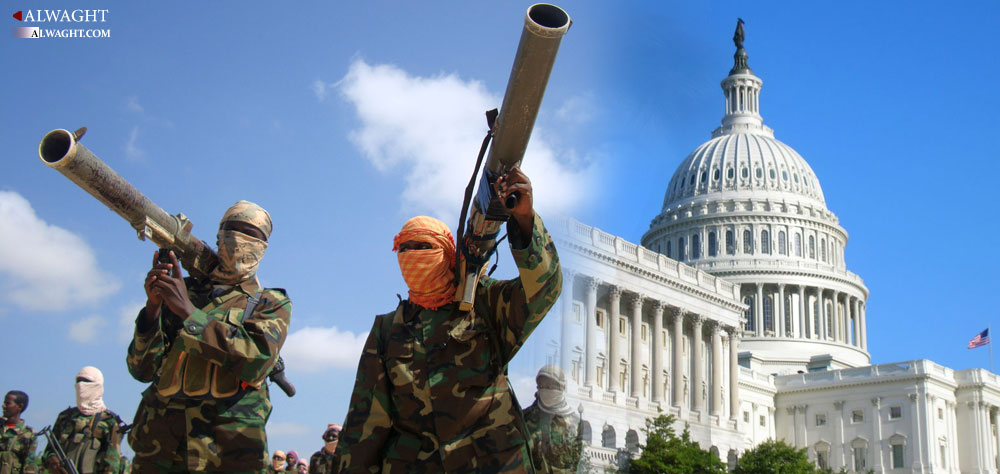Alwaght- Following end of the Second World War, the two winning powers, the US and Soviet Union, started a competition in a bid to expand their own areas of influence. As their rivalry went on, they involved in struggles, though indirectly. The best example was the Korean war of 1950.
To restrict the power of maneuvering of the opposite side, the two sides' leaders found creating and strengthening opposing groups near the other side’s territorial borders as an influential tactic. Creation of Al-Qaeda militant group in Afghanistan amid the Soviet Union’s invasion of the country with the ostensible aim of facing the impacts of interventions of the non-Muslims on the Muslim world came as part of this Western finding.
When the Soviet Union collapsed, the US needed to eliminate uncertainty from its geographical policy that was based on protecting the humanity from the violence. Therefore, Washington announced its major aim to be fighting the threats coming from a radical Islam. The questionable attacks on the World Trade Organization twin towers on September 11 gave Washington the excuse for military deployment to the Islamic nations, as at the same time the Congress got a push for approving the law called “Authorization for the Use of Military Force” (AUMF).
From that time on, the US military set high on its agenda fighting the “Islamist terrorism”, topped by the Al-Qaeda terrorist group. Al-Qaeda which later produced offspring like ISIS, al-Nusra Front, Boko Haram, and Yemen’s Al-Qaeda declared their task to be trying to establish the so-called Islamic caliphate across the Muslim world and fighting non-Muslims who put hurdles ahead of this end. So, Al-Qaeda set up the transnational networks of operation to carry out attacks in the Western countries, like the London metro suicide attacks of the 2006, a step that garnered adequate support of the US public opinion and other allied nations for waging wars in the West Asia region.
After Barack Obama won US presidency, the White House justified further use of the AUMF, expanding the US military forces' activities to include the whole West Asia and North Africa. Accordingly, during the eight years of Obama’s presidency, the US pressed on the argument that it needed to obliterate Al-Qaeda's affiliates, an insistence that pushed Washington to launch direct wars in Iraq, Libya, Syria, and Yemen, though the campaigns came under the cover of military actions of the anti-ISIS international military coalition formed by a symbolic presence of 50 countries.
To arrange its bombing campaigns against Al-Qaeda, ISIS, Boko Haram in Somalia, and Yemen’s Al-Qaeda, the White House boosted its military bases in Djibouti, Nigeria, Cameroon, Central African Republic, Egypt, Jordan, Iraq, Turkey, and the Persian Gulf Arab states. But, increase of its military personnel and equipment in these regions failed to yield practical outcomes.
For example, according to a White House report recently issued, the US deployed a number of its special military forces to Yemen to supposedly back the operation against the Al-Qaeda in the Arab Peninsula (AQAP). The report adds that the US launched 18 airstrikes since June 13 this year. But the air raids proved unviable in prevention of Al-Qaeda's gain of ground in Yemen amid power vacuum in this country as a result of the Saudi Arabian aggression against its neighbor. Since rise of ISIS terrorist group in Syria and Iraq in 2014, the Americans launched over 1,000 strikes but failed to produce considerable results.
The White House officials enumerate the security threats posed by the terrorist groups, particularly Al-Qaeda and its affiliates, to the global interests, but at the same time insist that there is no way yet they can give an accurate picture of the scale or time needed for the international military forces in the Pacific, West Asia, and Africa deployed to fight the terrorist threats.
The US sent well-equipped military forces to some spots in its Central, Pacific, Europe, Southern, and Africa commands. Such an activity and deployment come in compliance with the government laws and the AUMF. These forces' operations also come according to the AUMF.
But no specific time is predictable for return of the deployed US forces to home. Even president-elect Trump, with his isolationist stances, cannot influence the current US strategy in this case. Regarding the map of distribution of the US military forces around the world, we come up with the notion that the American leaders picked the deployment spots for specific objectives and actually fight against terrorism is a cover and pretext for Washington to chase its national interests.
At the time being, over 2,300 US troops are present in Jordan with the excuse of supporting the anti-ISIS military operations in both Syria and Iraq as well as protecting domestic security of Jordan. Jordan's significance for the US's West Asian strategy comes from the latter’s policy of providing the security of the Israeli regime. On the other side, the American military bases in the Persian Gulf region can guarantee further domination of the energy resources of the Arab countries.
Furthermore, a sinus chart of the Taliban, Al-Qaeda, and very recently ISIS power gaining process in Afghanistan can tell us that withdrawal of 9,800 US troops from the war-torn country is impossible– at least– in the medium term. This means continuation of the US military presence close to the Russian, Chinese, and Iranian borders.
The importance of the African countries, particularly Egypt and Djibouti, for Washington is because of their geostrategic position in the Red Sea, the Mediterranean Sea, Tiran and Bab-el-Mandeb straits, and the Gulf of Aden. The rich natural resources of other countries like Somalia, Nigeria, and Libya are the key drive behind Washington’s counterterrorist strategy.
So, instability, sectarian and ethnic gaps, increased security costs, surge in poverty, ignorance, and diseases are the outcomes the international community faces from the US liberating operations in its preemptive anti-radicalism wars.



























